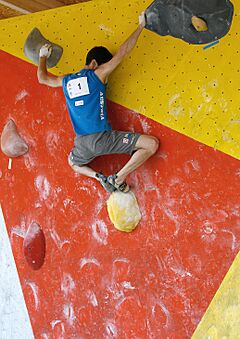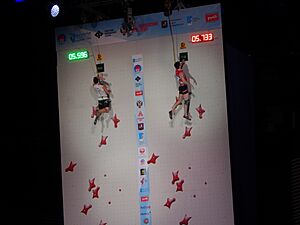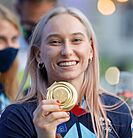Competition climbing facts for kids
| Highest governing body | IFSC |
|---|---|
| Nicknames | Sport climbing |
| First played | 1985 (Lead), 1998 (Bouldering, Speed) |
| Characteristics | |
| Type | Individual sport |
| Equipment | Shoes, chalk, harness, rope, quickdraws |
| Venue | Indoor climbing wall |
| Presence | |
| Olympic | Since 2020 |
| World Games | 2005–present |
Competition climbing is an exciting sport where people climb indoors on special walls. It's like rock climbing, but in a competition! Climbers try to reach the top of challenging routes.
There are three main types of competition climbing: lead climbing, bouldering, and speed climbing. Sometimes, climbers compete in all three types. Their scores are combined to find an overall winner. This sport is sometimes called sport climbing, which can be a bit confusing. Sport climbing also refers to a type of outdoor rock climbing where safety bolts are already in place.
In competition lead climbing, climbers try to go as high as possible on a tall wall. They clip their rope into safety points as they climb. In competition bouldering, climbers solve short, tricky problems without a rope. They focus on finishing as many problems as they can. In competition speed climbing, climbers race up a standard wall as fast as they can.
The International Federation of Sport Climbing (IFSC) organizes big international events. These include the IFSC Climbing World Championships and the IFSC Climbing World Cup. Competition climbing was first part of the Summer Olympics in 2020. At those Olympics, all three types of climbing were combined into one event. For the 2024 Olympics, speed climbing will be a separate event. Lead climbing and bouldering will still be combined.
Contents
History of Competition Climbing
Competition climbing started in the mid-1980s. This was around the same time that sport climbing became popular. Sport climbing is a type of rock climbing where safety bolts are already placed in the rock. This means climbers don't have to worry as much about setting up their own safety gear.
Some people weren't sure about having climbing competitions at first. But in 1985, the first big international climbing competition happened. It was called Sportroccia. This event later became the yearly Rock Master competition. These early competitions were for lead climbing and were held outdoors on real rock. Famous climbers like Stefan Glowacz and Catherine Destivelle were among the first winners.
In 1988, it was decided that competitions should be held indoors on artificial climbing walls. The UIAA (an international climbing group) started to organize these events. In 1989, the first UIAA Climbing World Cup took place. In 1991, the first UIAA World Climbing Championships was held. By 1998, bouldering and speed climbing were added to the competitions.
In 2005, competition climbing became part of the World Games. A new group, the International Federation of Sport Climbing (IFSC), took over organizing the competitions in 2006.
In August 2016, the Olympics announced that climbing would be in the 2020 Summer Olympics. All three climbing types (lead, bouldering, and speed) were combined into one medal event. This allowed more climbing to be shown at the Olympics. In August 2021, Alberto Ginés López and Janja Garnbret won the first Olympic climbing gold medals.
For the 2024 Paris Olympics, the rules changed again. Lead climbing and bouldering will be combined into one event. Speed climbing will be a separate event with its own medals.
Climbing Disciplines Explained
Competition Lead Climbing

In competition lead climbing, climbers have 6 minutes to climb a challenging route. The route is about 15 meters (50 feet) tall and often leans outwards. Safety ropes are already set up with quickdraws. Climbers must clip their safety rope into these quickdraws as they go up. If they miss a quickdraw, their climb ends there.
A special person called a route setter designs each route. Climbers get only one try to climb the route. Their score is based on the highest hold they control before falling. If they use that hold to try and reach the next one, they get a "+" added to their score. For example, if they fall while reaching for hold 35 from hold 34, their score is "34+".
Before climbing, competitors can look at the route for 6 minutes. After that, they go to an isolation area. This stops them from watching other climbers. It also prevents them from learning the beta (tips on how to climb the route). This means they have to climb the route as if they've never seen it before, which is called an onsight climb.
Competition Bouldering
In competition bouldering, climbers have to solve several short climbing problems. These problems are usually about 4.5 meters (15 feet) tall. Unlike lead climbing, climbers don't use ropes. Instead, thick crash pads are placed on the ground to keep them safe if they fall.
Climbers can try each problem multiple times within a time limit. This is usually 5 minutes in qualifying rounds and 4 minutes in finals. Each problem has a clear start position for all four limbs. A climber finishes a problem when they place both hands on the marked "top" hold and hold it long enough for a judge to confirm.
There are also "zone holds" in the middle of each problem. If a climber reaches a zone hold but can't finish the problem, they get half a point. Climbers cannot watch each other's attempts. This helps keep the competition fair. Scores are based on how many problems are "topped" (completed), how many "zone holds" are reached, and how few tries it took.
Competition Speed Climbing
In speed climbing competitions, climbers race up a 15-meter (50-foot) wall. The wall leans back slightly by 5 degrees. The holds on a speed climbing wall are always the same size and in the exact same places. This means climbers can practice the route over and over.
In the first round, climbers race in pairs. They are racing against the clock, not each other. Each climber races twice, once in each lane. The 16 fastest climbers move on to the finals. In the finals, climbers race head-to-head. The winner of each race moves on until the overall winner is found.
Major Competitions
IFSC Events
The International Federation of Sport Climbing (IFSC) runs the most important climbing competitions:
- IFSC Climbing World Championships: This event happens every two years. Medals are given for lead climbing, bouldering, speed climbing, and a combined event.
- IFSC Climbing World Cup: This is an annual competition. It's made up of several smaller events held throughout the year. Medals are awarded for lead, bouldering, speed, and combined events.
Olympics
Climbing was first included in the 2020 Olympics. At these games, climbers competed in a special combined format. Their scores from lead, bouldering, and speed climbing were added together for one medal. The winners in 2020 were Alberto Ginés López (men) and Janja Garnbret (women).
For the 2024 Olympics, the format is changing. Speed climbing will be a separate event with its own medals. Lead climbing and bouldering will still be combined into one event.
Famous Competition Climbers
As of 2023, some of the most successful male competition climbers are:
- Jakob Schubert from Austria
- Adam Ondra from the Czech Republic
- François Legrand from France
Legrand is known as the most successful lead competition climber. Kilian Fischhuber from Austria is the most successful bouldering climber. Zhong Qixin from China is the most successful speed climber.
For female competition climbers, some of the most successful are:
- Janja Garnbret from Slovenia
- Sandrine Levet from France
- Angela Eiter from Austria
Janja Garnbret is also the most successful lead competition climber. Sandrine Levet is the most successful bouldering climber. Tatiana Ruyga from Russia is the most successful speed climber.
Janja Garnbret is considered one of the most dominant competition climbers of all time, for both men and women.









